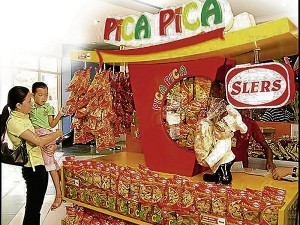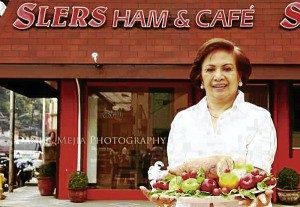SLERS Ham: From P10 to P40M

CAGAYAN DE ORO CITY—This city is known as the City of Golden Friendship for valid reasons. Cagayan-ons are known to be gentle and genteel, cheerful and friendly even to strangers.
Cagayan de Oro is also home to an excellent ham-making tradition, which has spawned an estimated 40 plus ham makers, big and small.
Among the leading ham makers in this city is SLERS Industries which has come a long way from being the kitchen-based business it was in the 60s to the dynamic, global, multi-product enterprise it is now. The growth it has achieved was driven by modern systems and relentless product development.
There are two enterprising women responsible for what SLERS has become: Fely Pelaez, the school teacher turned ingenious cook who began ham-making for household use and then made a promising cottage enterprise out of it; and her daughter Mercedes Pelaez Mejia who established systems, diversified production and marketing, and adopted food-making technology and international standards of quality.
Where it started
It began in Bukidnon in the ’60s, recounts Fely Pelaez, still pretty and chic at 81. Her husband, who comes from Cebu, was working for the Del Monte Pineapple Corporation, which was raising its own hogs in the company compound. It was also making its own American country-style ham and all families of the staff, both Filipino and American, were given one leg each every Christmas.
“I loved cooking and making all kinds of food stuff from scratch. I experimented with ham-making using the country-style ham as model.” Basically adopting the technology used at Del Monte, she came up with her own version: Combination American style ham and Chinese ham. “Meaty, juicy, and not too salty.”
Fely would bring her ham to Cebu during Pelaez family reunions, winning raves. Relatives and eventually friends ordered the ham every Christmas. Soon, Fely was making it on a year-round basis as her market increased.
In 1969, Fely established SLERS (an acronym that stood for the names of the five Pelaez children) with P10 capital.
She then registered the business with the now defunct National Cottage Industries Development Administration (NACIDA) which granted her a P5,000-loan.
At first, Fely’s hams were being patronized by a handful of loyal customers, with some military officers in Metro Manila sending helicopters to Bukidnon to pick them up. In time, SLERS ham became available at supermarkets. Among her biggest customers was the Philippine Sugar Commission (Philsucom) in Manila to which she would ship 5,000 legs of ham in a refrigerated 20 ft container van at Christmas time.
Growing SLERS
In 1988, when daughter Mercedes, then already married , joined the company, Fely appointed her Managing Director.
A BS Tourism graduate of the University of the Philippines Diliman, Mercedes engaged in a flurry of innovations that parlayed the erstwhile little-known micro business into one of the biggest and most dynamic food enterprises in Misamis Oriental.
SLERS now produces and sells ham and other meat products at a volume of 2,000 kg a day in major supermarkets such as SM, Robinsons, Gaisano and Ororama in Cagayan de Oro and the rest of Mindanao. The products are also distributed through seven company-owned outlets known as SLERS Pica-pica . The company also owns two dining places that sell SLERS products as meals: SLERS Express Meals and SLERS Ham and Café.
From P10 capital, the company now has P40 million in capital assets.
A plethora of innovations
Among the innovations Mercedes introduced, the most visible is product development.
SLERS ham has diversified into many variants: Leg ham or Jamon Cagayan de Oro, country ham, picnic ham, country style ham, sweet ham, and pear-shaped ham. Other items are smoked bacon, beef pastrami, longganisa, chicken ham, smoked pork loin, and—most recently —chicharon.

Mercedes made it clear that the legs of ham, as originally formulated by her mom Fely, were basically unchanged. The only adjustments made were on the salt level.
Packaging innovations were also introduced. From mano-mano packaging, the products are now packed by machine in special nitrogen packs.
The legs of hams are vacuum sealed then put in attractive katsa bags.
A keen observer of market movements, Mercedes studies which needs are not yet being filled, which was how SLERS tocino came to be. She makes it a point to observe the reaction of customers during taste tests and product sampling at point-of purchase. Her own taste is another source of ideas and insights. “If I like it, others may like it too.”
Assistance of suppliers has proven invaluable, too, to SLERS’s growth. Companies that supply materials and machines are always ready to help in setting up production.
Recently, she had consultants from the Canadian Expert Services Organization (Ceso) and the Canadian Industrial Development Agency (Cida) who spent a few weeks at SLERS studying the company operations and making recommendations on how to improve production systems, produce in volume, and maintain equipment to eliminate downtime. Consultants have also helped in documenting and improving other related systems, including accounting and marketing.
SLERs pioneered in Cagayan de Oro in takal-takal or tingi-tingi selling of tocino and longganisa instead of simply selling in packs. “This gives customers the power to choose how they want to buy their meat products.”
Ham is still SLER’s flagship product. But close behind it is chicharon, a product she did not imagine producing. It was a stroke of bad luck turned good which led her to the product. She recalls how:
A side story:
SLERS chicharon
In 2005, the company was in a quandary when major meat suppliers, which used to deliver meat already cut according to SLERS’ specifications, closed down. Mercedes was forced to buy whole hogs from a farm and have them slaughtered. The arrangement worked well enough, except that she was stumped what to do with pork skin. At first she tried to sell these to chicharon-makers but they could only absorb so much.
“There I was with a ton of pork skin,” she chuckles. “I went online and googled “chicharon making” and then bought a DVD from TLRC which basically gave instructions on how to cook a kilo of pork skin in a little carajay, not a ton of it.” She took things into her own hands, cooking in her kitchen and learning about time and temperature. “Nothing like actual experience,” she concludes.
Today, chicharon is one of SLERS’ fastest growing products. It has become so popular the company now has to buy pork skin from abroad to cope with demand.
Rewards
All the hard work and innovations seem to be reaping returns for Mercedes.
Last year, she was cited as one of the “Inspiring CDO Entrepreneurs” by the Philippine Center for Entrepreneurs (PICE) which runs the Go Negosyo campaign.
But the biggest reward for her is being able to provide a livelihood for many of her fellow Cagayan-ons who she considers her extended family.
When Tropical Storm “Sendong” devastated CDO last December, she worried sick over her workers, some of whom failed to report to work during the first weeks following the deluge.
As it turned out, 23 of them were badly affected. She bought them food and relief goods and helped make sure they were evacuated and sheltered.
SLERS is now implementing a continuing program for the psychological debriefing of its workers who were victims of the disaster. The company also organized soup kitchens and food stations for the larger community of victims and donated three Portalets for the evacuation centers.
Mercedes concludes her narrative with a tribute to her mom, Fely Pelaez, who began the business.
“Over the years, my mother’s vision became the guiding force of SLERS. We stand by the quality she has always insisted on. And with innovation, we are making sure we grow into a force to reckon with. ”
“I still run to my mom for advice now and then,” she hastens to add.
(The story of innovation of SLERS Ham is among cases to be featured in an upcoming book by the Small Enterprises Research and Development Foundation on “Product Strategies of Small Businesses.” For other entrepreneurial success stores and start-your-business and improve-your-business how-to’s, visit the SERDEF website at www.serdef.org.)
